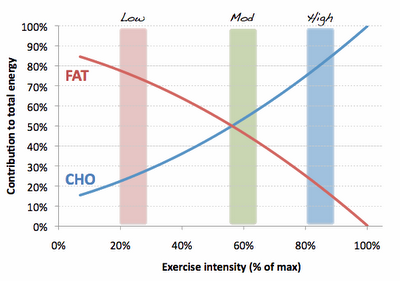To understand what anaerobic means, let me explain a couple of things about where your energy comes from:

When at rest, most of your energy comes from fat. But as soon as you start to exercise, your metabolism kicks in and increases proportionally to your rate of work. But because burning fat happens too slow and requires a lot of oxygen (CO2) to burn, you gradually start to burn glycogen (CHO) instead. The relation between these two is pretty much inverse, which means that the harder you start working, the less fat and the more glycogen you start burning. All the while, your heart rate and oxygen uptake increase pretty much linearly. This phase is called the aerobic phase ("with oxygen"), because you have sufficient oxygen to burn both the fat and the glycogen.
Until you start reaching a point where your cardiovascular (heart + vessels) or respiratory (lungs) system are starting to lag behind the required lung ventilation. This point is called your lactate threshold and indicates that you're starting to accumulate too much lactate in your blood. Lactate is the by product of anaerobic glycolysis, because you burned the glycogen with insufficient oxygen. A second thing that happens is that your red blood cells get saturated with carbon dioxide (CO2), it can take up less oxygen to supply the muscles with 'fresh air'. The phase above the lactate threshold is the anaerboic phase.

If you keep increasing the load from this point on, your body is starting to saturate and you're rapidly depleting your glycogen resources. Unless you're a highly trained athlete, these levels of exercise (80-90% of your maximal oxygen uptake) are generally hard to sustain for long periods of time.
But as you can see a lot of factors are involved in determining your where your aerobic phase starts. Your heart has to be able to increase its heart rate and increase the blood pressure, your lungs have to ventilate old air out and new air in and transfer O2/CO2 with the blood, blood has to transfer O2/CO2 with both the lungs and the muscles and your muscles have to produce energy, contract and relax and transfer all the involved products.
And all these factors together determine your anaerobic capabilities.
This is also dependent on how well you are trained. The more trained you are, the higher levels of lactate you can sustain, the more glycogen you have in your muscles or even the more blood you have (and many more).
So how does this apply to you?
Assuming your maximal heart rate lies at 200 bpm and you're working out at 170, that's 85% of your maximal capacity. My cynical guess is that your heart rate monitor is slightly off. One way of determining whether it's correct is trying your own VO2Max-test only without the actual oxygen testing.
Follow a standard testing protocol to test how your heart rate increases when you incrementally increase the home trainers wattage until you can no longer sustain the load. That's a fair guess estimate of your real maximum and will give you an idea whether 170 bpm is around or above your lactate threshold.
I greatly simplified several aspects, if you have any questions or find that I need to explain something, just leave a comment

